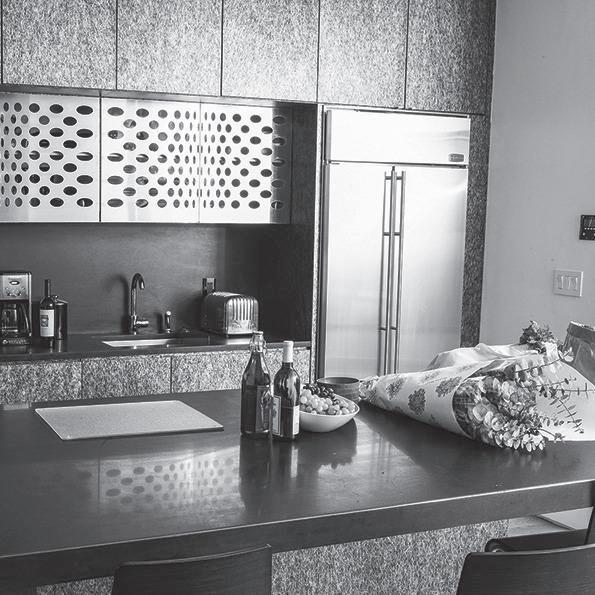
10 minute read
Sundance Realy
HOME TIPS Small kitchen improvements that maximize functionality BY METRO SERVICES can move items out of drawers and off of counters. REAL ESTATE FEATURES Consider an under-the-cabinet toaster oven and micro-
Many homeowners wish for expansive kitchens. wave to create more counter space. Modernized kitchens that include sought after Use scaled-down appliances features and showcase the latest trends go a long way to improving the overall value of a home. Shop with size in mind when looking at new appli-
As desirable as such kitchens may be, some homes won’t take up as much space as larger alternatives. simply don’t have enough space for a centerfold-worthy Homeowners should consider the ultimate function of kitchen featuring an island, wine refrigerator and walk- the kitchen and then think about which appliances will in pantry. However, homeowners with small kitchens serve them well. can still improve the form and function of their existing spaces. Add some glass Reconfigure and revamp cabinetry The DIY Network recommends incorporating glass
Homeowners whose kitchens are small often lament Glass lets you see through the objects, thereby enhanctheir lack of storage. Redesigning the layout of cabinets, and possibly adding some more cabinetry, may ances if you have a small kitchen. Compact versions to improve the perception of space in small kitchens. ing the feeling of spaciousness or what designers call take care of certain storage issues. The experts at Merit “negative space.” Kitchens suggest utilizing corner space with LeMans Embrace high-end materials units, lazy susans and other gadgets to make access to It costs less to renovate small spaces than bigger these areas easier. areas, so homeowners may be able to afford high-end
Work with the walls materials that really add personality to a kitchen.
Small kitchens require clever usage of vertical space. Small kitchens can be culinary havens with the right Vertical storage units, hooks, shelving, and more improvements to maximize the space.
MIKE BAN MARTY JANET ARGEVITCHJANET ARGEVITCH MICHELLE
ASSOCIATE BROKER LENTZ ASSOCIATE BROKERAssociate Broker DOMINGO MICHELLE DOMINGO 957-5522
MIKE BAN
209-6842 Associate Broker 209-6842 321-3325 723-9333 72-9333 957-5522 Michelle.juneau80@yahoo.com mikebanatexitrealty@gmail.com mikebanatexitrealty@gmail.com Marty-lentz@gci.net MARTY LENTZ Ja@alaskan.com Michelle.juneau80@yahoo.com
ja@alaskan.com 321-3325 Marty-lentz@gci.net
Ala sk a S e a f ood C omp a ny • A ski ng $ 2 ,2 0 0 ,0 0 0
MOLLY BRINK 321-5400
ANAVERA ANAVERA MORATO 5731 Concrete Way Juneau, AK 99801 MOLLY mgallagherbrink@gmail.com LUKE
MORATO321-0293 Anavera.morato@gmail.com 907-321-7120 BRINK GUNKEL 321-0293 321-5400 723-0759S u n dance i nj un e a u@g ma il. com Anavera.morato@gmail.com Mgallagherbrink@gmail.com ltgunkel@gmail.com9 1 0 9 Me nd e nha ll M a ll R oa d , S ui t e # 1 0 Juneau, AK 99801
SUNDANCE REALTY 907-321-7120 JuneauHomeFinder.com SCAN TO SEE ALL OUR PROPERTIES RESIDENTIAL, COMMERCIAL, INDUSTRIAL AND PROPERTY MANAGEMENT. WE SERVE ALL OF SOUTHEAST

PET SAV V Y Storage solutions for pet supplies
BY METRO SERVICES
REAL ESTATE FEATURES
Pet owners soon learn that having a pet means carving out a portion of home real estate for all of the supplies necessary for keeping companion animals healthy and comfortable. From food to toys to bedding, many pets require a laundry list of items. Developing a storage strategy means keeping items within reach but potentially out of sight. These suggestions can help individuals calm pet-related clutter.
Food storage Many dry pet foods are sold in bulk, which can be convenient for pet parents. Buying in quantity not only reduces the number of shopping trips, it also can help keep per-unit costs down. The U.S. Food & Drug Adminstration notes that proper storage of pet food and treats helps maintain the products’ nutritional value and prevents spoilage. It also can keep pets from getting into their food and eating too much. Purchase a food grade and BPA-free plastic storage container that can accommodate the volume of food and has an airtight lid to maintain freshness. If you are pouring the food directly into the container, save the product UPC code, brand name, lot number, and “best by” date from the packaging in case you need to file a complaint about the food. Small containers can be used for treats or other edible items. Store all food in a cool, dry place. Toys and more Investing in some similarly sized clear storage containers makes it easy to wrangle all of the accessories that come with pet ownership. Label the containers and fill them with the items you need, such as rubber balls, pet waste bags, coiled leashes or collars, squeaking toys, grooming brushes and combs, extra bird cuttlebones, fish nets, warming stones, or whatever other supplies are needed for pets large and small. Devote a shelf or shelves in a storage closet for these items so they’re always readily available.

Medications Store medications separately from products used for children and adults in the house. Keep medications in the original packages so labels can be referred to as needed. Place them in a sealed container so they’re not easily opened by children or pets.
Toys in use Many dogs and cats (or other small animals allowed to roam the house) will want access to their favorite toys. An easy solution is a ground-level basket that is slipped under a side table in the living room or den. It’s easily accessible but kept out of sight. Clean-up means a quick sweep of toys that quickly can be tossed in the basket.
Bedding Depending on the animal, bedding may mean a cozy stuffed fabric bed or a pile of shaved cedar. Both can be bulky. A designated spot for storage helps keep the home organized, and dog and cat beds can be coordinated to the color scheme of the house so they blend in. Pets require many different supplies that, when properly stored, will not seem like they’re intruding on pet owners’ space.
RENTAL TIPS Benefits to open concept floor plans
B Y M E T R O M E D I A
R E A L E S TAT E F E AT U R E S
The way a home is designed can say a lot of things about it. In fact, many real estate professionals and contractors can determine when a home was built based on the design of its interior. For example, homes with sunken living rooms were likely built sometime in the 1960s and 1970s.
Open concept living rooms are one trend that might one day make people nostalgic for the early 21st century. Many of today’s home buyers want homes with open concept floor plans, which can give homes a more spacious feel, perhaps even creating the illusion that a home is bigger than it really is.
Home buyers who have never before enjoyed open concept floor plans can consider these benefits to these wildly popular layouts. Entertainment
Many people who live in homes with open concept floor plans cite their convenience when entertaining as one of their biggest assets. In an open concept home, guests don’t have to be corralled into a single room in the home. Instead, hosts and their guests can roam freely from room to room because there are no walls dividing common areas. This can make gatherings feel less cramped than in homes with more traditional floor plans. Safety
The safety of open concept floor plans may be most applicable to parents of young children. Open concept floor plans allow parents to keep an eye on their children while cooking dinner, working from home or tending to other chores around the house. Since there are no walls to divide rooms in open concept homes, parents don’t have to wonder what their curious kids are up to because they can see them at all times. Flexibility
Open concept floor plans give homeowners more flexibility. For example, homes with more traditional floor plans may have designated spaces for dining areas. These spaces don’t leave much room to work with and may not be valued by homeowners who don’t often host dinners at home. As a result, such rooms may just be wasted square footage. With an open concept floor plan, homeowners have the flexibility to make dining areas as big or small as they see fit and can even adjust the rooms on the fly on those occasions when people are coming over.
Open concept floor plans continue to be popular among home buyers and might prove to be the most lasting home design trend of the early 21st century

HOME BUYERS How to manage relocating for a new job
B Y M E T R O S E R V I C E S
R E A L E S TAT E F E AT U R E S
Moving can be a considerable undertaking. While working professionals who are single or married with no children may find it easier to move than men and women with families, it’s fair to say that anyone who is moving in the near future has some significant work ahead of them.
In its Job Relocation Survey, the moving company Allied Van Lines found that people move for a variety of reasons. Fifty percent of the 3,500 respondents indicated they relocated for career advancement or money, and many more indicated they relocated because of a job transfer (12 percent), their companies moved (9 percent) and to be closer to family/relationships (8 percent).
Regardless of what’s motivating men and women to relocate, and whether or not they’re relocating on their own or uprooting their families, various strategies can make a forthcoming move go more smoothly. • Inquire about relocation assistance. The Allied survey found that 63 percent of companies offered relocation packages. That’s a considerable perk, as moving can be expensive, especially for adults moving to different parts of the country. Asking about relocation expenses before being offered a job can be tricky, but some companies may mention such packages in their job ads or in their initial meetings with out-of-town candidates. • Ask what relocation packages cover. Relocation packages vary from company to company. The Allied Survey found that 54 percent of companies that offered such packages covered moving expenses, while 21 percent gave new hires a lump sum of money to use as they deemed necessary. One in five companies even sponsored trips to search for homes. Adults who are offered relocation packages should get the specifics so they can start creating moving budgets. • Emphasize organization. Much of the stress associated with relocating can be traced to the logistics of uprooting oneself and one’s family. Men and women who are unaccustomed to making lists may want to start, as doing so can help keep track of all the tasks that need to be completed before hitting the road. Various unique tasks, from canceling utilities to changing insurance policies, must be completed before moving, and it’s easy to lose track of what’s been done and what hasn’t. Maintaining a to-do list and checking off tasks as they’re completed can simplify the relocation process.
• Rent your first home. The Allied survey found that 31 percent of respondents indicated the most challenging part of relocating for a job was finding a home, while 29 percent felt acclimating to their new community was the most challenging aspect of their relocation. Adults who rent their first homes upon relocating can remove some of the pressure to find the perfect home, knowing full well their first home in their new community will be temporary. If possible, rent in a location that makes it easy to immerse yourself in your new community, which should make the adjustment easier. In addition, place items that are unnecessary for day-to-day life in storage. Having some of your possessions already packed should make your next move less stressful.
Relocating for a job can be exciting and stressful. But there are ways to make moving go smoothly.



